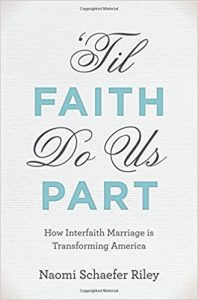‘Til Faith Do Us Part: How Interfaith Marriage is Transforming America
by Naomi Schaefer Riley
 When Naomi Schaefer Riley was ready to introduce her African American fiance to her Jewish parents, she wasn’t too worried about his race. But she was very concerned about his religion—he’s a lapsed Jehovah’s Witness.
When Naomi Schaefer Riley was ready to introduce her African American fiance to her Jewish parents, she wasn’t too worried about his race. But she was very concerned about his religion—he’s a lapsed Jehovah’s Witness.
When it comes to marriage, Riley says that differences of race and culture are increasingly seen as superficial. Differences over religion are another matter. Religious beliefs and feelings, often deep-seated, can come to the fore when interfaith couples plan their wedding or welcome their first child.
Riley does not seek to discourage interfaith marriages. Rather, she hopes to make people aware of the powerful hold exerted by religious traditions, even on those who have stopped practicing their faith. Few people are aware of the problem. She says: “Interfaith couples tend to marry without thinking through the practical implications of their religious differences.”
Why does this matter? Research suggests that interfaith couples are often less happy and their unions less stable than same faith couples. They are also more vulnerable to divorce. They are less likely to raise their children religiously, which can lead to a general waning of religious traditions. Riley regrets this development, because America’s religious communities have contributed significantly to the country’s “generosity and compassion.”
Much of the book draws on an Interfaith Marriage Survey that Riley commissioned in order to make comparisons between interfaith and same faith couples. Her survey found that interfaith marriage in the U.S. is on the rise, with an interfaith marriage rate of 42%. Jews are the most likely and Mormons the least likely to marry members of other faiths. (Among married Catholics, about 28% have a non-Catholic spouse, according to a study from the Center for Applied Research in the Apostolate.)
The book covers the hard topics: dating; planning an interfaith wedding; raising children; celebrating holidays; divorce; and congregational attitudes towards interfaith couples. All are difficult, but deciding how to raise the children is probably the most perplexing issue that interfaith couples face. Riley’s interviews with interfaith parents, enlightening and sometimes heartbreaking, confirm that in many instances neither parent is the “winner.”
It’s hard to argue with Riley’s conclusion that interfaith couples should discuss their religious differences before the wedding. They need to get over their starry-eyed naiveté that love will conquer all and think in practical terms about what their faith differences will mean.
It’s doubtful, however, that many couples are equipped—or motivated—to begin and sustain such a conversation. Here is where those who prepare couples for marriage can play a vital role. Clergy and other ministers can help couples to begin the dialogue, perhaps by offering questions and carefully leading them to tackle the tough issues, such as children. While interfaith couples need much the same assistance as same faith couples, they also need help that is specifically suited to their situation. If interfaith couples and religious leaders need convincing, ‘Til Faith Do Us Part is a good place to start.
About the reviewer
Sheila Garcia works in the Secretariat of Laity, Marriage, Family Life and Youth at the United States Conference of Catholic Bishops.
Disclaimer: Book reviews do not imply and are not to be used as official endorsement by the USCCB of the work or those associated with the work. Book reviews are solely intended as a resource regarding publications that might be of interest to For Your Marriage visitors.




